Ranked: My favourite Singapore Airlines Business Class seats – The MileLion
Singapore Airlines has five different Business Class seats across its fleet, and not all are made equal.
Some are better for working and lounging, others for sleeping. Some offer all-aisle access, others make you step over a seatmate. And since they all cost the same number of miles to redeem, the last thing you want is to draw the short straw!
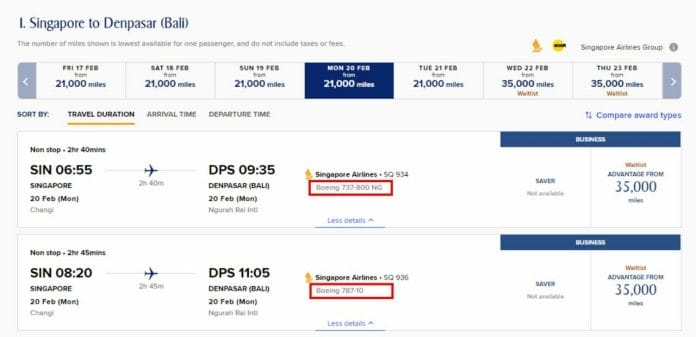
I’ve flown dozens (dozens!) of Singapore Airlines flights, but don’t think I’ve actually shared my overall ranking of which ones I like the best.
That changes now.
Mục Lục
Overview: Singapore Airlines Business Class seats
Here’s a brief overview of the five types of Business Class seats you’ll find across the Singapore Airlines fleet.
Seat
Aircraft
(no. in service)
Current Age*
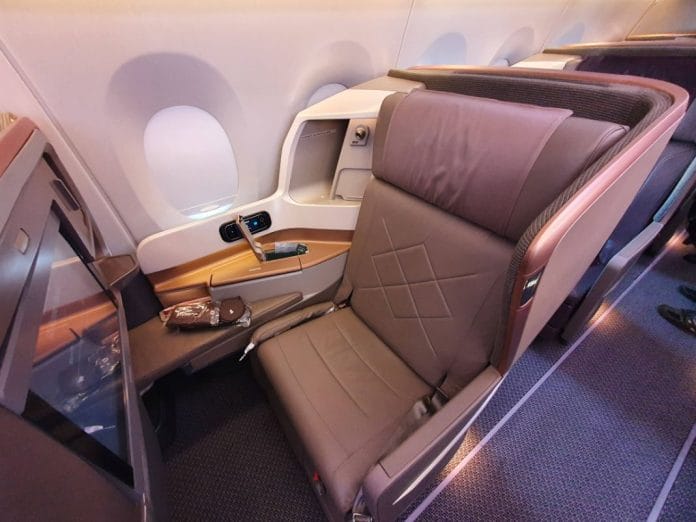
2013J
A350-900ULR (7)
A350-900LH (30)
B777-300ER (23)
10 years

2014RJ
B737-800 (7)
9 years
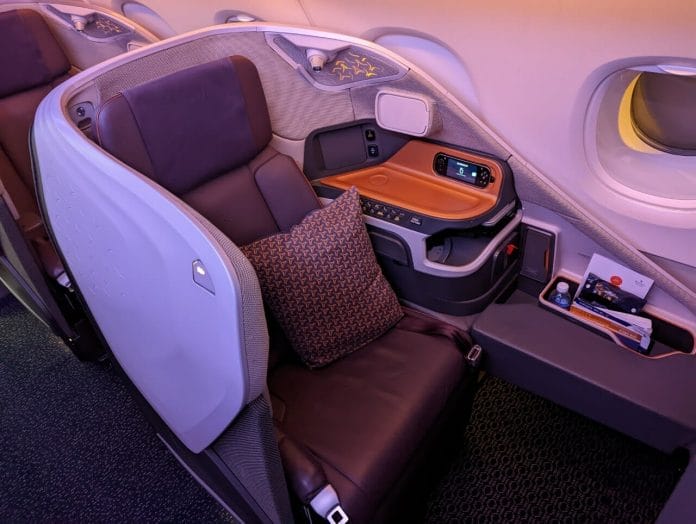 2017J
2017J
A380-800 (12)
6 years
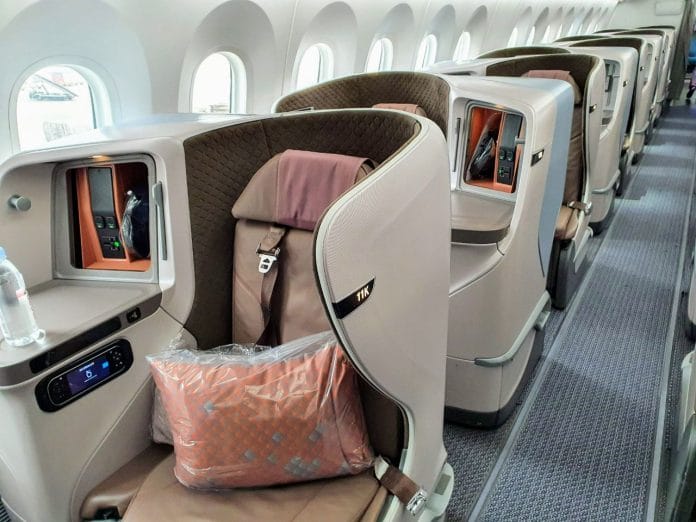
2018RJ
A350-900MH (24)
B787-10 (15)
5 years
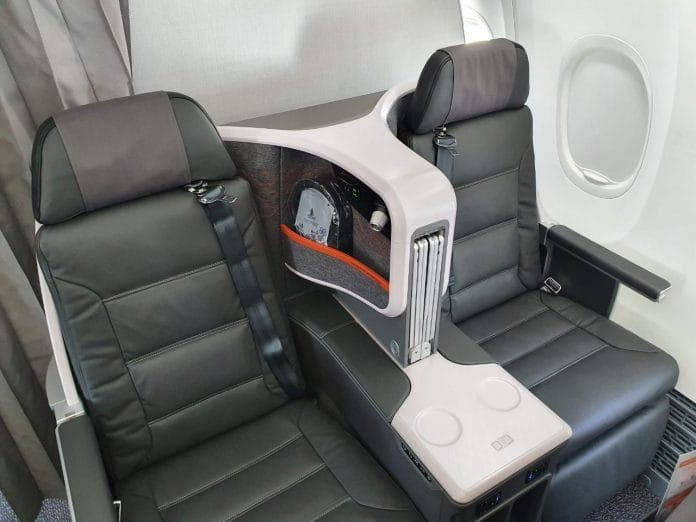
2021RJ
B737-8 (16)
2 years
*Age refers to when the product was first introduced, not necessarily the physical age of the seat you’ll encounter
For convenience, we use abbreviations like “2018RJ” when referring to products, where 2018 = the year the seat debuted, RJ= regional Business Class.
There used to be even more variety, but during the pandemic we said goodbye to the oversized 2006J and angled-flat 2009RJ seats, which were found on the since-retired A330-300s, older A380-800s, and B777-200/300 aircraft. I had a soft spot for the 2006J seat (which critics said was “too wide”, can you believe that), but I’m glad the 2009RJ is gone forever!
For anyone nostalgic, you can read reviews of the two seats below:
#1: 2018 Regional Business Class
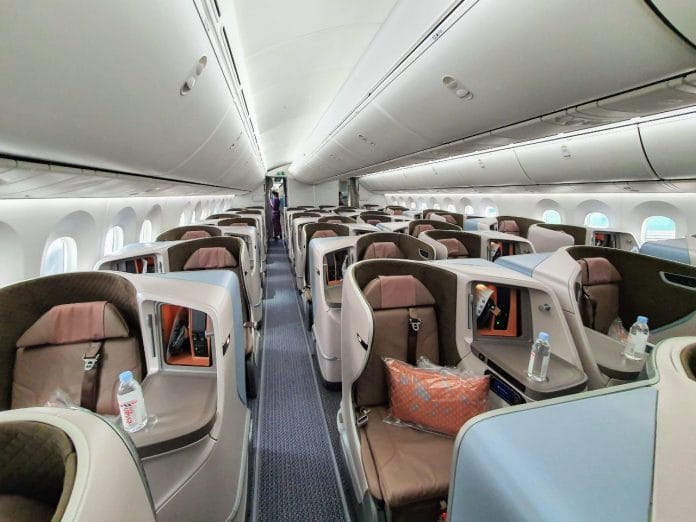 ✈️ Singapore Airlines 2018RJ
✈️ Singapore Airlines 2018RJ
👍 Pros
👎 Cons
-
All aisle access
-
Seat reclines to flat without needing flipping
-
Very comfortable sleeping surface that’s suitable for back-sleepers
-
Not very couple-friendly
-
May be too narrow for certain passengers
-
Three-point seatbelt
It may sound surprising that my favourite Singapore Airlines Business Class seat is an off-the-shelf product (Stelia Aerospace Symphony) deployed on regional routes, but hear me out.
The 2018 Regional Business Class seats can be found on A350-900 Medium Haul and B787-10 aircraft, which generally fly routes of up to seven hours. They’re laid out in a 1-2-1 configuration giving every passenger direct aisle access, a big improvement over the 2-2-2 configuration found on the now-retired A330-300s and B777-200/300 jets.
The cabin feels very private, thanks to the high walls and dividers, and you shouldn’t be too disturbed even if you end up with one of the seats closer to the aisle side thanks to the privacy wings.


A storage cubby provides plenty of space for loose items, and I particularly appreciate this seat has 2x USB ports. I carry two phones with me (my Blackberry and Pixel 7 Pro), and being able to charge both at the same time is always an added convenience.
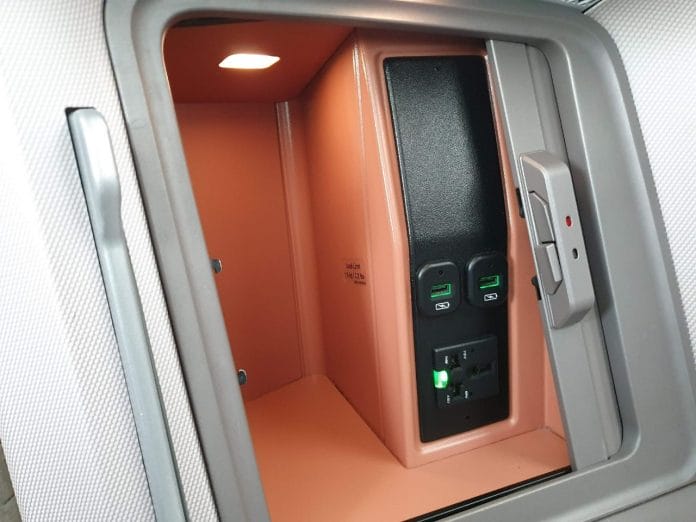
But my favourite feature of this seat by far is the sleep experience.
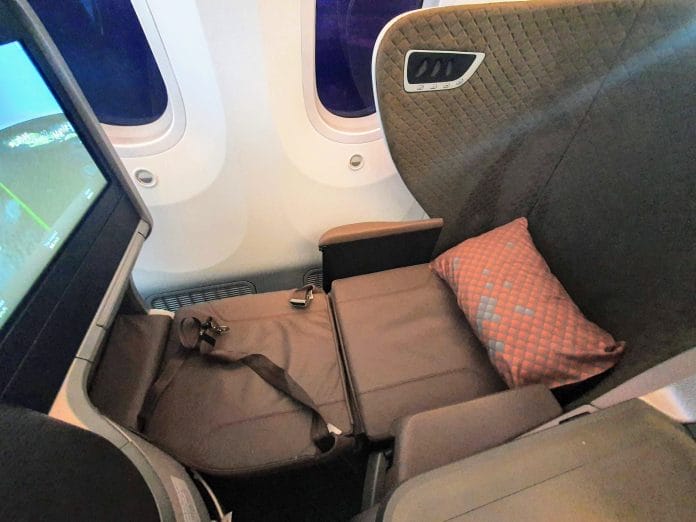
First, there’s no need to stand up and flip it over, which means that on a red-eye flight, you can recline and sleep from the moment the plane takes-off (and I have seen passengers doing it during taxiing, which is somewhat unadvisable). If you were on an aircraft with the 2013J seat, you’d need to wait till the seatbelt sign went off at cruising altitude before you could get up and flip the bed
Second, this design allows you to recline the seat to any angle you wish, which (surprisingly) makes the 2018RJ the first lie-flat Singapore Airlines seat with this capability. Call me weird, but I don’t actually like to sleep on a 180° surface. I much prefer 160-170°, which I find to be less stressful on my lower back. Even if you’re not sleeping, the ability to take a wide range of lounging positions makes the 2018RJ a better option for working or relaxing.
Third, you sleep straight instead of diagonally. Diagonal sleeping, required on the 2013J and 2017J, is a huge bugbear for some.
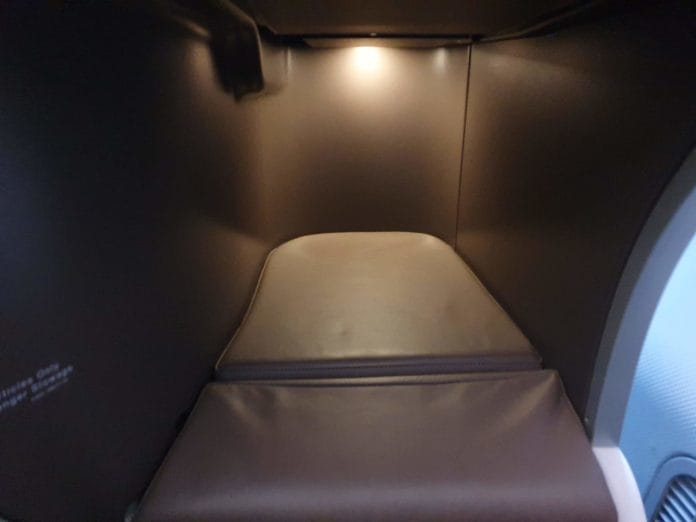
Fourth, despite the seat’s narrow dimensions, the footwell is actually slightly larger than what you’ll find on the 2013J seats. This means it’s much more comfortable for back sleepers, of whom I’m one.
Some drawbacks exist.
First, these aren’t the most couple-friendly seats; even if you pick the “honeymoon” pair in the middle, it’ll be difficult to interact with your travel companion due to the privacy wings.

Second, at 20″ wide, these seats will be very narrow for anyone used to Singapore Airlines’ long-haul Business Class (which starts from 25″). You can lower the armrests to get an additional 6″ or so of width, but passengers of size may not find it comfortable.
Third, the three-point seatbelt design is inherently more restrictive than a lap band, but you’ll only need to fasten the shoulder strap during taxi, take-off and landing.
None of these are deal-breakers for me, which is why I’d call this my favourite Business Class seat in the whole fleet.
Full review
A full review of the 2018RJ seat can be found below.
#2: 2017 Business Class
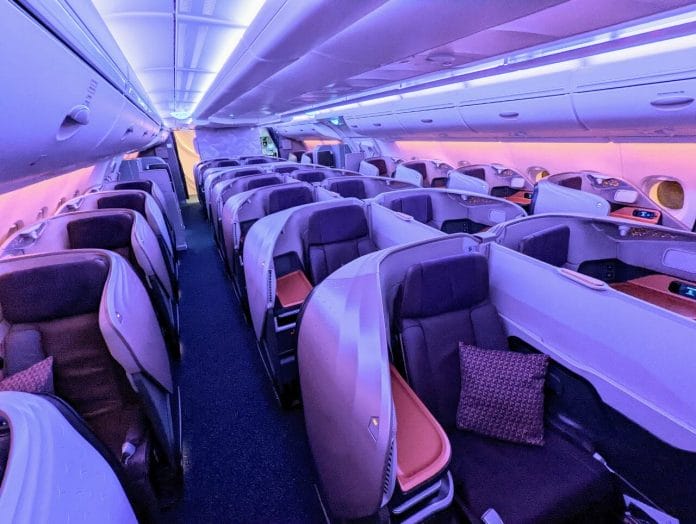 ✈️ Singapore Airlines 2017J
✈️ Singapore Airlines 2017J
👍 Pros
👎 Cons
-
All-aisle access
-
The most couple-friendly seat in the fleet
-
Seat reclines to flat without needing flipping
-
Extremely private
-
Double bed more gimmick than gamechanger
-
Sleeping surface is uncomfortably firm
Singapore Airlines’ 2017 Business Class seat is confusing, to say the least. Despite the substantial development costs, it will only ever be deployed on the airline’s 12 A380-800s. Given the very specific routes these aircraft ply, many SIA flyers may never cross paths with one of these for their entire service duration.
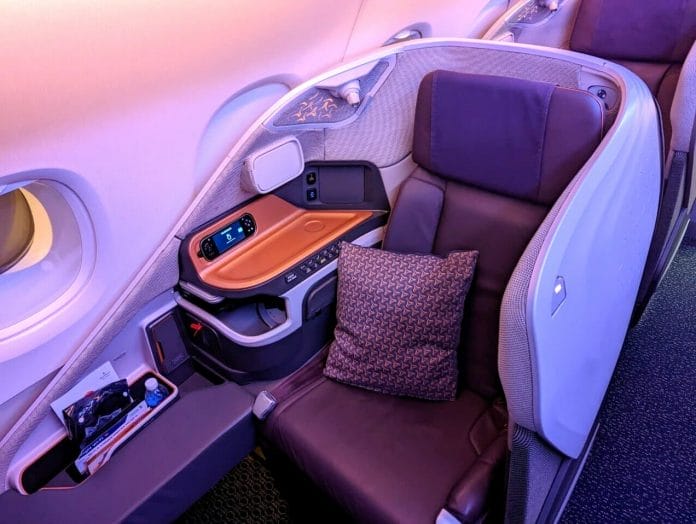
It’s a shame, because there are a lot of good ideas here. This 1-2-1 configured long-haul product offers excellent privacy and noise isolation thanks to its walls and sound-dampening materials. And yet, it’s also the most couple-friendly seat in the whole fleet, because of the lack of wraparound privacy wings between centre seats. When the divider is lowered, you can have a conversation and share food without having to lean forward, the only Singapore Airlines Business Class seat that allows this.

It gets even better if you manage to get the 11D/F, 91D/F or 96D/F seats, where the divider goes all the way to the bottom. These seats can also be converted into a double bed, though I find the concept a bit gimmicky since it’s more like two beds pushed together. The firm and unforgiving central divider is painful to lie on, even with blankets, and it’s only a double bed for the top half of your body; your feet will be separated. Still a fun experience, but perhaps not a must-do.
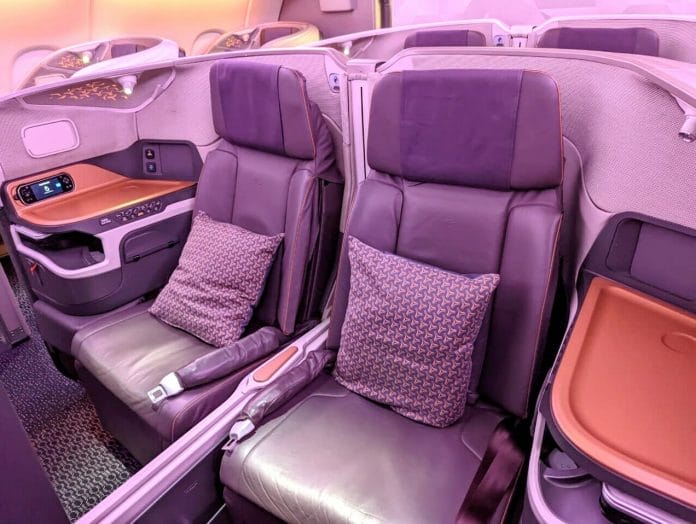
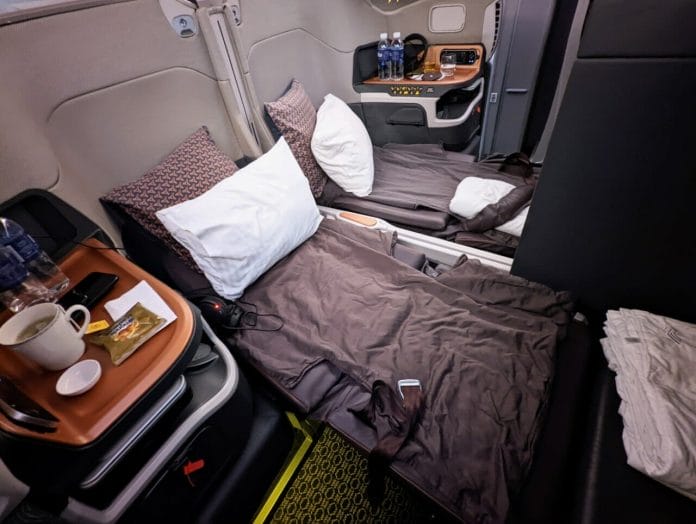
The 2017J is one of the few seats that doesn’t hold you captive whenever the tray table is deployed. You can slide it forward to enter and exit the seat, useful during mealtimes or when you’re doing work and need a quick comfort break.
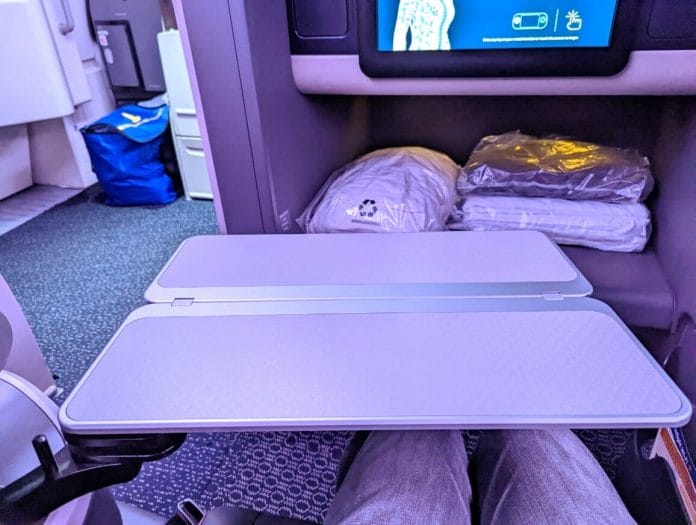
Like the 2018RJ seat, the 2017J seat can be converted into a bed without standing up. That has the added benefit of letting you sleep at any angle, but my main gripe with this seat is that the cushioning is very, very firm. I mean, I’m used to a firm mattress at home, and I found this uncomfortable.
Also, I’m not sure if it’s just my bad luck, but the seat I tried had a noticeable joint where the seat cushion joins the seat back. This created an annoying bump near my lower back, and I didn’t sleep very well.
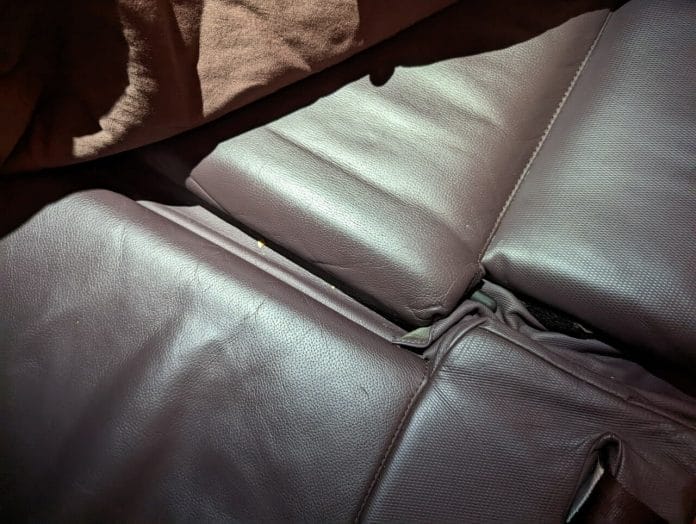
Moreover, you’ll need to sleep diagonally unless you’re in a bulkhead row. The cubby is on the narrow side, and not particularly friendly towards back sleepers.
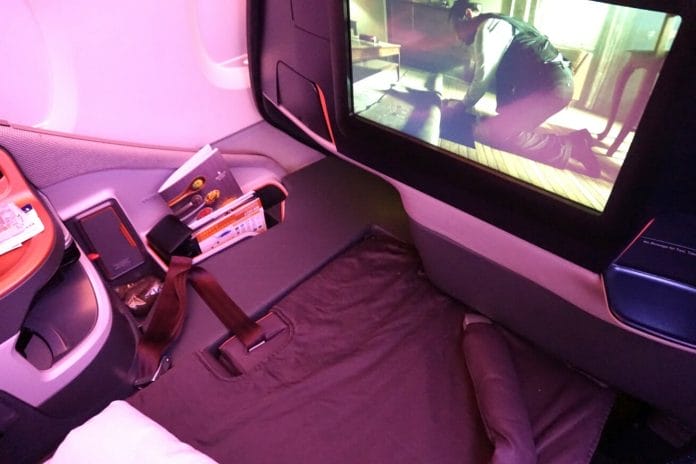
If you’re taking a daytime flight or are lucky enough to be able to sleep anywhere, it’s unlikely these factors will come into play. And I still reckon the overall sleep experience is better than the 2013J seat, for what it’s worth.
Full review
A full review of the 2017J seat can be found below.
#3: 2021 Regional Business Class
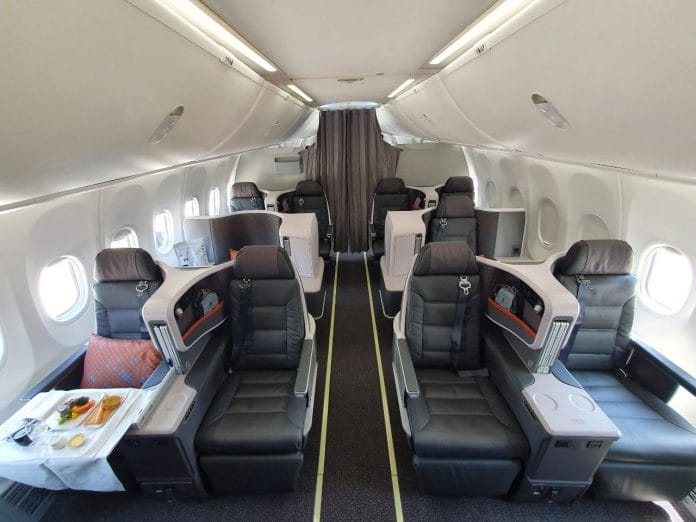 ✈️ Singapore Airlines 2021RJ
✈️ Singapore Airlines 2021RJ
👍 Pros
👎 Cons
-
A full-flat bed on even the shortest of flights
-
Throne seats offer excellent personal space
-
Seat reclines to flat without need for flipping
-
No aisle access for 40% of passengers
-
Undersized tray table
-
Seat may be too narrow for some
-
Three-point seatbelt
Singapore Airlines’ latest regional Business Class product is found exclusively on the B737 MAX 8 (internally designated as the B737-8, the MAX being removed for obvious reasons), and like the 2017J seat, reclines into a full flat bed with no need to flip it over.

This means a wide ranger range of seating positions, useful on a short flight where you might do work and catch a quick nap before landing, without going flat at all.
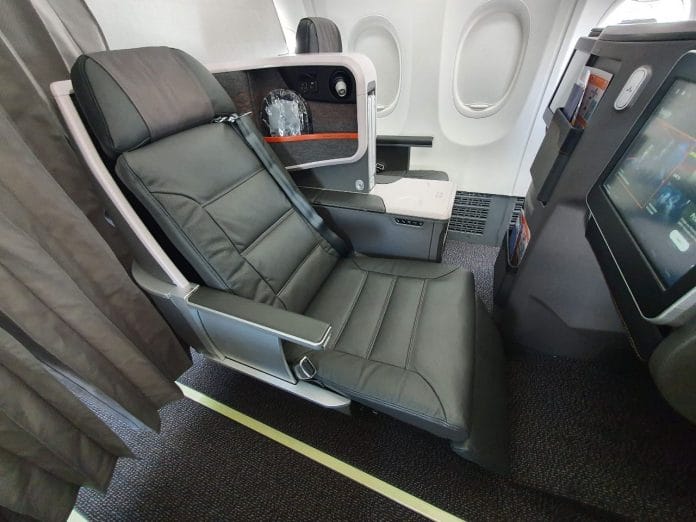
Of course, full flat is an option. Some people argue that a flatbed seat is overkill for short flights. Some people have no joy in their lives. Moreover, if you’re a jetlagged passenger stepping off a long-haul flight onto a regional connection, I’m sure you’d appreciate the opportunity to catch a quick nap en route to your final destination.
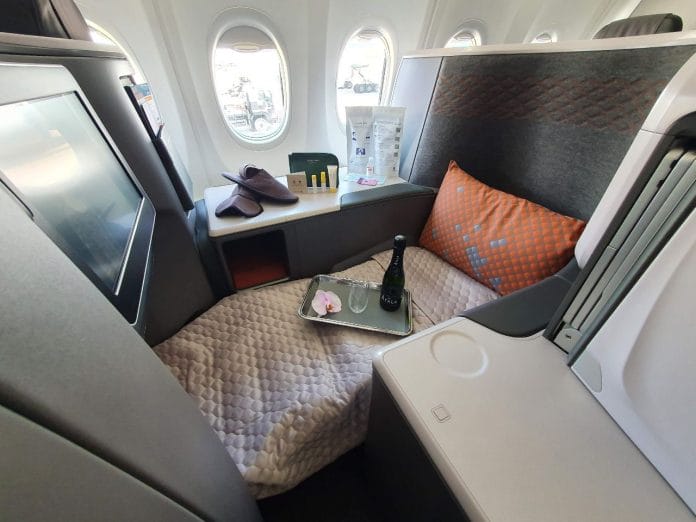
The 10 Business Class seats are laid out in a 2-2, 1-1, 2-2 configuration. The layout creates a pair of throne seats, which enjoy additional storage space thanks to their dual armrests and personal storage cabinet.
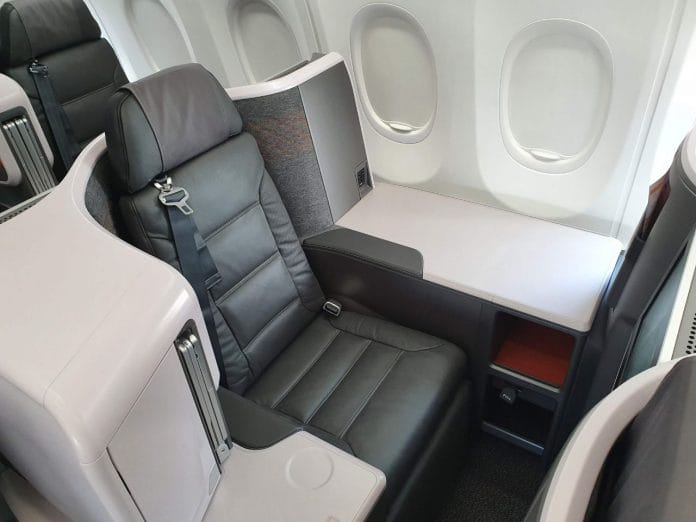
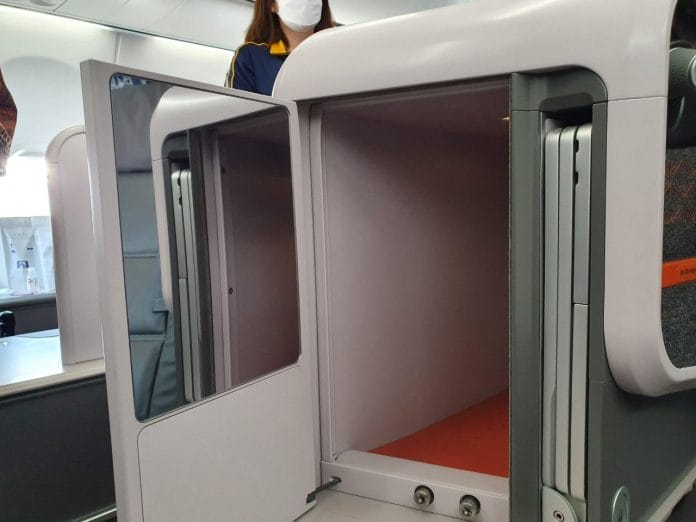
I would have thought the throne seats would be the first to get snapped up, but on most of my flights so far they’ve been the leftovers. That’s probably because I’ve flown the B737-8 mostly to leisure destinations like Da Nang and Phuket, where holidaying couples pick the twin seats.
Of course, the layout also means that 40% of passengers don’t have direct aisle access, and 40% will have to be “cowboy stepped” over by their seatmate at some point during the flight. That’s not necessarily a deal-breaker on a narrowbody jet, since all-aisle access is hardly the market standard (some commenters complained that JetBlue offers it, conveniently forgetting that the Mint Suite is only deployed on high-yield routes like New York to London, while SIA’s B737-8s need to serve all its regional destinations).
While the 2021RJ seat is snug at 19-21″ wide, I find the sleeping experience to be superior to the 2013J seat because you can recline to any angle, and also sleep facing forward. Regardless of which row you pick, all the footwells are friendly towards back sleeping, with the bulkhead row 11 having the most room.
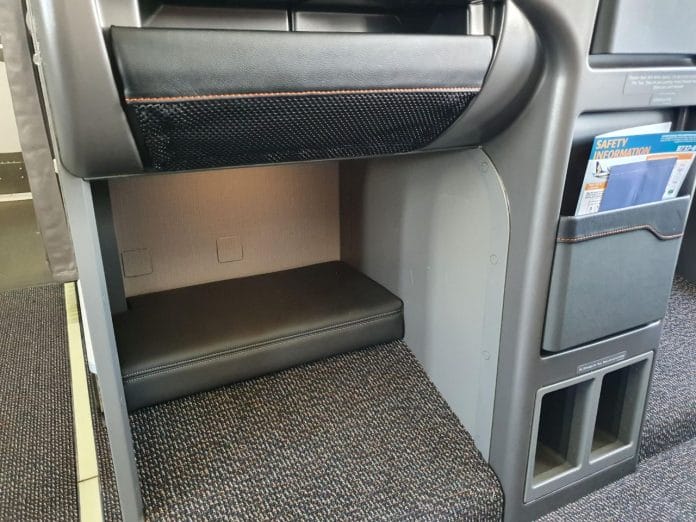

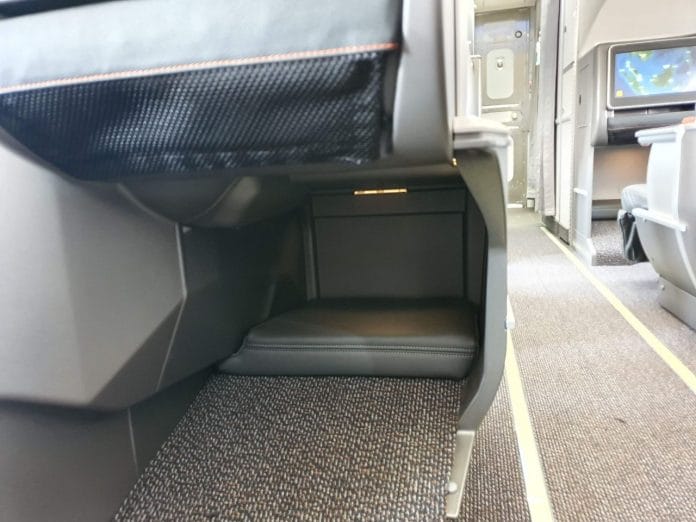
While I suppose it’s an inevitable compromise on a narrowbody jet, the tray table was smaller than what I’m used to. A 14-inch laptop just about fit, but with minimal space to rest your wrists, much less a beverage.

And finally, do note that like the 2018RJ seat, the 2021RJ seat uses a three point seatbelt.
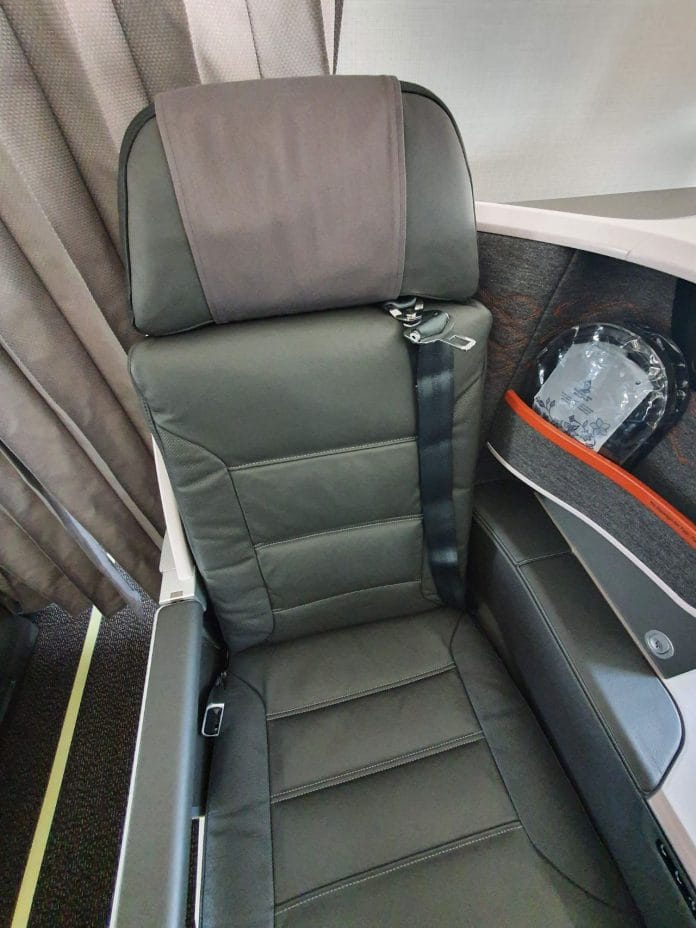
Full review
A full review of the 2021J seat can be found below.
#4: 2013 Business Class
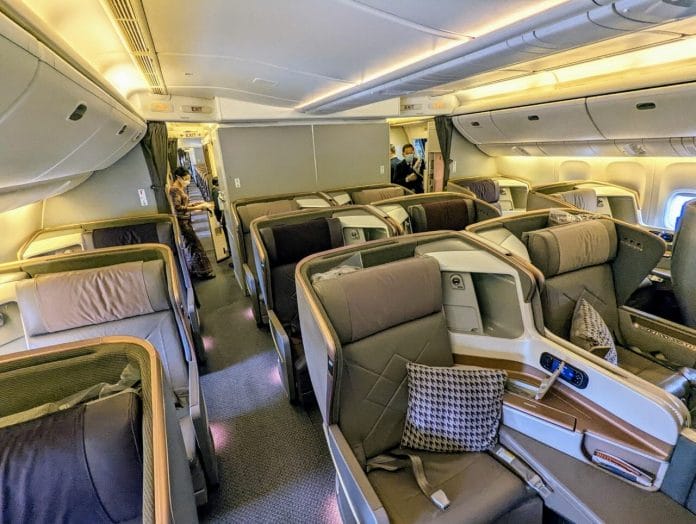 ✈️ Singapore Airlines 2013J
✈️ Singapore Airlines 2013J
👍 Pros
👎 Cons
-
All-aisle access
-
Still one of the more private Business Class seats out there, despite the lack of a door
-
Very tight footwell, especially on the A350s
-
Limited range of lounging positions
-
Seat must be flipped over to convert into bed
-
Sleeping surface may be uneven, depending on your luck
Installed on all 60 A350-900LH/ULRs and B777-300ERs, the 2013J is the de facto long-haul seat for the Singapore Airlines fleet (the 2017J seat, remember, appears on just one dozen aircraft) until the long-delayed B777X and its new Business Class seats show up in 2025 (we hope).
In terms of style, it’s a modest evolution of the now-retired 2006J seat. That’s not necessarily a bad thing, mind you, given how the 2006J seat was already ahead of its time when it first debuted. But having turned a decade old this year, there is visible wear and tear, and some of the competition (most notably ANA and Qatar Airways) have started to pull ahead.

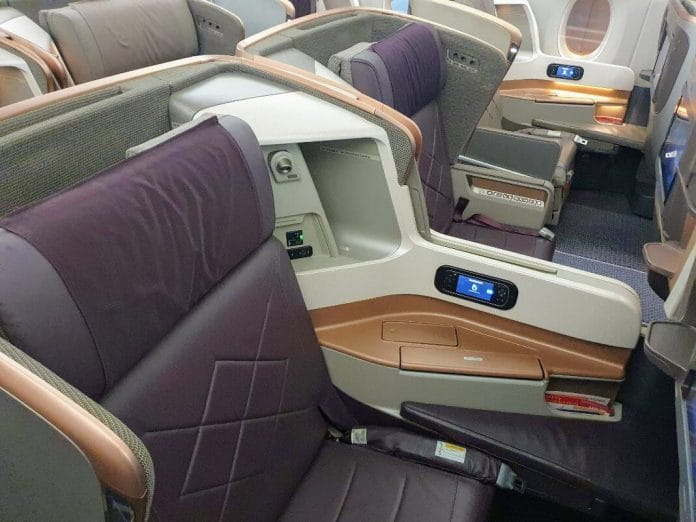
The seat definitely has some things going for it. Despite the lack of sliding doors, I find it to be very private because of the oversized shell and movable central divider. Moreover, it’s reasonably well designed, with various storage nooks and power outlets within easy reach.

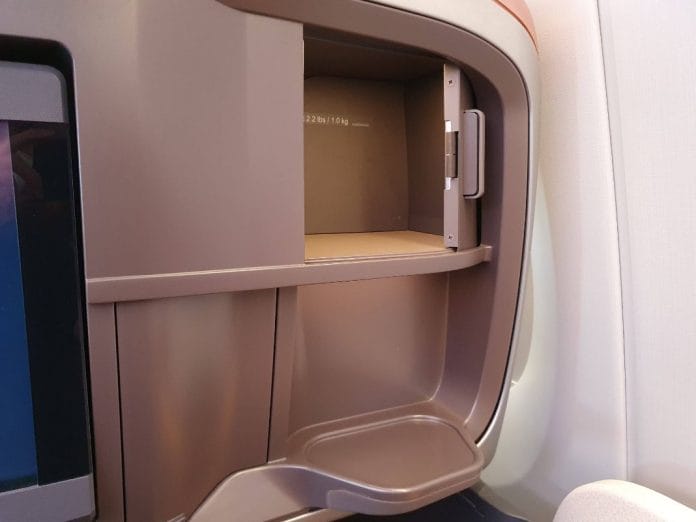
Where it stumbles is the sleep experience. It must be flipped over into a bed, which means you can’t do anything until the seat belt sign is off and limits the range of lounging positions you can take. In theory, a flip-over design provides a uniform sleeping surface because it avoids the crevices created by the joints of a regular recliner. However, years of wear have caused some seats to pop up in weird spots, most notably the part near the feet.
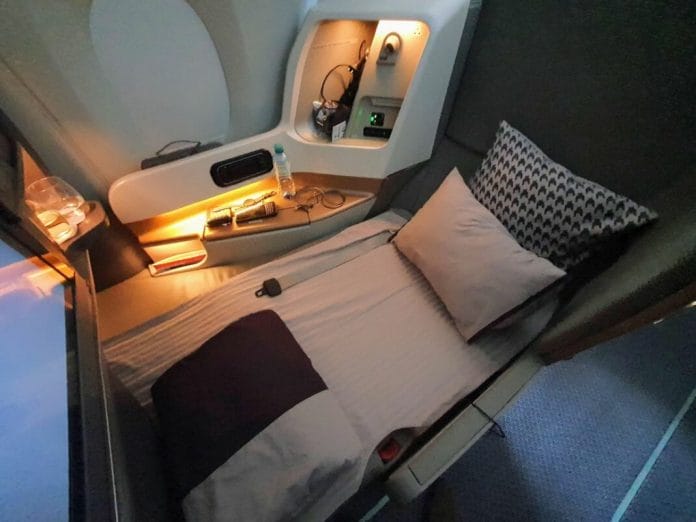
The 2013J seat is also infamous for its narrow footwell. Unless you’re fortunate enough to score one of the eight bulkhead seats, you’ll need to sleep diagonally, with your feet crammed into a small cubby. Side sleepers will largely be fine; back sleepers may be in for a rough night. This is more acutely felt on the A350-900s than the B777-300ERs, since their narrower fuselage makes it that much more snug.

Personally, I’ve never had a great night’s sleep in one of these seats, and together with the restricted lounging positions, makes this one of my less-preferred Business Class products. I should emphasise that this doesn’t make it a bad seat by any means—I’d still pick it over Business Class on many other airlines — just that it doesn’t perform as well as the rest of what SIA has to offer.
Full review
A full review of the 2013J seat can be found below.
#5: 2014 Regional Business Class
 ✈️ Singapore Airlines 2014RJ
✈️ Singapore Airlines 2014RJ
👍 Pros
👎 Cons
-
With every month that goes by, the chances of encountering one of these declines
-
Non-powered recliner seat with end-of-life mechanicals
-
I mean, just look at it
Singapore Airlines inherited nine B737-800s from its merger with SilkAir, of which seven are still operating. These aircraft were delivered to SilkAir from 2014 onwards, and even though they’re not the oldest seats in the fleet, still manage to look ancient.
The only changes Singapore Airlines made upon acquisition was to give them some new upholstery, but that still can’t hide how retro they are. I flew one of these six years ago when it was operated by SilkAir, and even then it was rather dire. Seat recline and leg rests rely on manual operation; some were so loose they rattled around disconcertingly, others so tight you needed superhuman strength to force them into position. The lumbar support was saggy, there’s no privacy to speak of, and forget about Wi-Fi or seatback IFE (wireless entertainment streaming is possible, to be fair).
Oh, and at the risk of stating the obvious, the 2-2 configuration means 50% of passengers can’t access the aisle directly (and the remaining 50% will get bothered every time they do).
What else is there to say about this seat? There’s really no reason you’d consciously choose it, assuming better alternatives exist. If it’s any consolation, you’ll only find the B737-800s flying on the shortest of routes, such as:
- Kuala Lumpur (45m)
- Medan (1h)
- Penang (1h)
- Phuket (1h 30m)
- Surabaya (2h)
- Bali (2h 10m)
- Yangon (2h 40m)
- Kathmandu (4h 30m)
Kathmandu is the lone outlier, probably deployed there because of the lack of premium demand.
It should be no surprise that this is easily my least favourite seat in the fleet, though I do have a morbid fascination with flying it just once, so I can say I’ve reviewed every Singapore Airlines product there is!
Conclusion
So that’s my ranking of Singapore Airlines’ Business Class seats, and I want to emphasise again that I like and dislike certain things because of my travel habits, the way I sleep, the way I work etc. It could very well be different for you.
I mean, I hated the angled-flat 2009 Regional Business Class seats, but know of some parents who loved it because it made it easy to keep track of their kids. It’s really a case of different strokes for different folks.
Man, I need to review that 2014RJ seat.
Which Singapore Airlines Business Class seat is your favourite?















![Toni Kroos là ai? [ sự thật về tiểu sử đầy đủ Toni Kroos ]](https://evbn.org/wp-content/uploads/New-Project-6635-1671934592.jpg)


